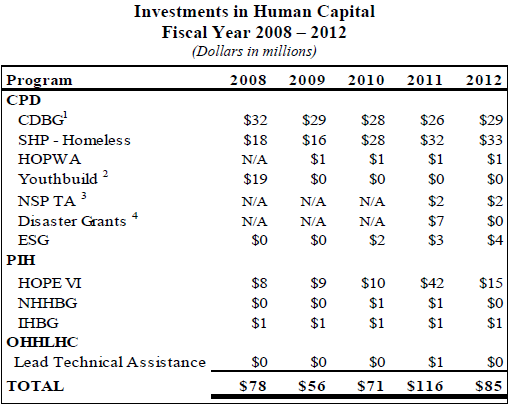REQUIRED SUPPLEMENTARY STEWARDSHIP INFORMATION
Introduction
This narrative provides information on resources utilized by HUD that do not meet the criteria for information required to be reported or audited in HUD’s financial statements but are, nonetheless, important to understand investments made by HUD for the benefit of the Nation. The stewardship objective requires that HUD also report on the broad outcomes of its actions associated with these resources. Such reporting will provide information that will help the reader to better assess the impact of HUD’s operations and activities.
HUD’s stewardship reporting responsibilities extend to the investments made by a number of HUD programs in Non-Federal Physical Property, Human Capital, and Research and Development. Due to the relative immateriality of the amounts and in the application of the related administrative costs, most of the investments reported reflect direct program costs only. The investments addressed in this narrative are attributable to programs administered through the following offices:
- Community Planning and Development (CPD),
- Public and Indian Housing (PIH),
- Policy Development and Research (PD&R), and
- Office of Healthy Homes and Lead Hazard Control (OHHLHC).
Overview of HUD's Major Programs
- CPD seeks to develop viable communities by promoting integrated approaches that provide decent housing, a suitable living environment, and expanded economic opportunities for low and moderate-income persons. HUD makes stewardship investments through the following CPD programs.
- Community Development Block Grants (CDBG) are provided to state and local communities, which use these funds to support a wide variety of community development activities within their jurisdictions. These activities are designed to benefit low- and moderate-income persons, aid in the prevention of slums and blight, and meet other urgent community development needs. State and local communities use the funds as they deem necessary, as long as the use of these funds meet at least one of these objectives. A portion of the funds supports the acquisition, construction or rehabilitation of permanent, residential structures that qualify as occupied by and benefiting low- and moderate-income persons, while other funds help to provide employment and job training to low- and moderate-income persons.
- Disaster Recovery Assistance is a CDBG program that helps state and local governments recover from major natural disasters. A portion of these funds can be used to acquire, rehabilitate, construct, or demolish physical property. Read more...
- Community Development Block Grants (CDBG) are provided to state and local communities, which use these funds to support a wide variety of community development activities within their jurisdictions. These activities are designed to benefit low- and moderate-income persons, aid in the prevention of slums and blight, and meet other urgent community development needs. State and local communities use the funds as they deem necessary, as long as the use of these funds meet at least one of these objectives. A portion of the funds supports the acquisition, construction or rehabilitation of permanent, residential structures that qualify as occupied by and benefiting low- and moderate-income persons, while other funds help to provide employment and job training to low- and moderate-income persons.
- PIH ensures safe, decent, and affordable housing, creates opportunities for residents' self sufficiency and economic independence, and assures the fiscal integrity of all program participants. HUD makes stewardship investments through the following PIH programs.
- The Public Housing (PH) Capital Fund provides grants to PHAs to improve the physical conditions and to upgrade the management and operation of existing public housing.
- HOPE VI Revitalization Grants (HOPE VI) provide support of the improvement of the living environment of public housing residents in distressed public housing units. Some investments support the acquisition, construction or rehabilitation of property owned by the PHA, state or local governments, while others help to provide education and job training to residents of the communities targeted for rehabilitation.
- Indian Housing Block Grants (IHBG) provide funds needed to allow tribal housing organizations to maintain existing units and to begin development of new units to meet their critical long-term housing needs. Read more...
- The Public Housing (PH) Capital Fund provides grants to PHAs to improve the physical conditions and to upgrade the management and operation of existing public housing.
- PD&R’s stewardship responsibilities include maintaining current information to monitor housing needs and housing market conditions, and to support and conduct research on priority housing and community development issues.
In prior years HUD made stewardship investments through the Community Development Work Study and the Partnership for Advancing Technology in Housing (PATH) program.
The OHHLHC program seeks to eliminate childhood lead poisoning caused by lead-based paint hazards and to address other childhood diseases and injuries, such as asthma, unintentional injury, and carbon monoxide poisoning, caused by substandard housing conditions.- The Lead Technical Assistance Division, in support of the Departmental Lead Hazard Control program, supports technical assistance and the conduct of technical studies and demonstrations to identify innovative methods to create lead-safe housing at reduced cost. In addition, these programs are designed to increase the awareness of lead professionals, parents, building owners, housing and public health professionals, and others with respect to lead-based paint and related property-based health issues. Read more...
RSSI REPORTING - HUD'S MAJOR PROGRAMS
Non-Federal Physical Property
Investment in Non-Federal Physical Property: Non-Federal physical property investments support the purchase, construction, or major renovation of physical property owned by state and local governments. Read more...
Human Capital
Investment in Human Capital: Human Capital investments support education and training programs that are intended to increase or maintain national economic productive capacity. Read more...
Research and Development
Investments in Research and Development: Research and development investments support (a) the search for new knowledge and/or (b) the refinement and application of knowledge or ideas, pertaining to development of new or improved products or processes. Research and development investments are intended to increase economic productive capacity or yield other future benefits. Read more...


